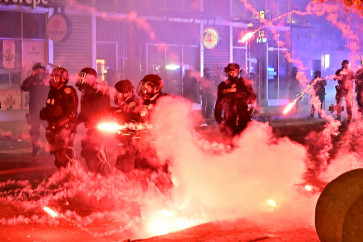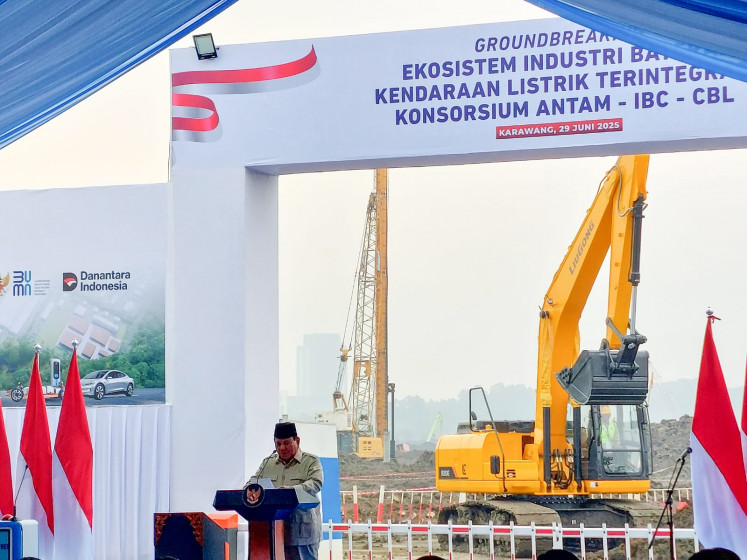Popular Reads
Top Results
Can't find what you're looking for?
View all search resultsPopular Reads
Top Results
Can't find what you're looking for?
View all search resultsProtection for refugees in Indonesia: A state responsibility
JP/Dhoni SetiawanRefugees in Indonesia have staged many rallies this year
Change text size
Gift Premium Articles
to Anyone

JP/Dhoni Setiawan
Refugees in Indonesia have staged many rallies this year. The street hosting the United Nations Refugee Agency (UNHCR) Indonesia, Jl. Kebon Sirih in Central Jakarta, was filled with refugees, requesting protection and a solution to their situation living in limbo for years, particularly from June to August.
Refugee migration is increasing worldwide as a result of civil wars and internal conflicts in various parts of the world. The UN estimates that as of last June, Indonesia had been a host to almost 14,000 refugees and asylum seekers from Afghanistan, Somalia, Iraq, Myanmar, Sudan, etc.
Indonesia has a responsibility as a state in providing protection for refugees and asylum seekers. Indonesia is not a signatory to the 1951 Refugee Convention and its 1967 Protocol. However, is being signatory to the aforementioned conventions the only pre-requisite for a state in providing protection for refugees in Indonesia?
As a member of the UN, Indonesia is signatory to eight core international human rights conventions, some of which have been adopted in domestic regulations. Apart from international conventions, Presidential Regulation 125/2016 on the treatment of refugees and asylum seekers in Indonesia has acknowledged and recognized refugees in a national legal context, even though protection clauses are lacking within the said regulation.
Ratifying an international convention may require the state to do more work, but further research is needed on the potential impacts on the state’s readiness in adhering to the international standards of human rights fulfillment, among other things. What are the current solutions for refugees and asylum seekers in Indonesia?
The UN cites three main durable solutions: assisted voluntary repatriation, resettlement and integration with the local community. The first choice is hardly a possible option as the conflicts in refugees’ country of origin rarely subside; while the non-refoulement principle under international customary law considers making refugees return to their own country and endangering their safety a breach of international law. Resettlement, which is highly hoped by refugees as the best solution for them, also does not seem possible with the rise of extreme nationalism, Islamophobia and resistance from countries such as Australia, the United States as well as European countries who used to accept refugees from Indonesia.
This situation leaves us with the third option. As a non-signatory member of the 1951 Refugee Convention and its Optional Protocol of 1967, the government might say integration with the local community is not a possible option. However, integration is inevitable between the refugee community and Indonesian society. The refugees have already started integrating in society ever since they arrived on Indonesian soil.
Ending the conflicts in the respective countries would be a utopic solution for refugee migration in general. With a minimum chance of going back to their countries and being resettled, living in limbo for more than eight years as the average waiting time to be resettled, has greatly affected the mental health of refugees in Indonesia. Assuming the average waiting time is lengthened due to the minimal successful resettlement cases and steady influx of refugees into Indonesia, the government must start preparing for the unavoidable consequences of the current situation by starting to provide basic rights to refugees and legal recognition.
In India, Tibetan refugees’ right to residency is contingent upon a Registration Certificate (RC) which is a legal document issued by Indian authorities, equivalent to an identity card. RC issuance to Tibetans started in 1956 when the Dalai Lama was exiled, followed by a mass exodus of Tibetan refugees into India. RCs are valued as they allow Tibetans to legally travel and work within the country, serving as an identity document and a prerequisite for an Identity Certificate. Although currently, the process to acquire an RC is arduous, the legal recognition remains clear for Tibetans in India.
In 2000, Malaysia as the host of more than 150,000 refugees and asylum seekers provided nonrenewable six-month work permits for Rohingya refugees from Myanmar. In 2015, Malaysia had considered in multiple cases the creation of temporary work permits. The permits were supposed to benefit Rohingya refugees to be legally employed in Malaysia, though the plan did not materialize.
Indonesia’s government can learn from the practices in India and Malaysia as progressive commitments from states who are not signatory to the 1951 Refugee Convention and its 1967 Protocol. For instance, Indonesia can create a Kartu Izin Tinggal Sementara untuk Pengungsi (Refugee Temporary Stay Permit Card) or collaborate in partnerships with local and international agencies to establish livelihood opportunities.
Indonesia has to adopt long-term strategies rather than ad-hoc policies to prevent a bottleneck in providing legal recognition as well as sufficient protection for refugees and asylum seekers.
____________________
Human rights lawyer and member of SUAKA, an association advocating protection for asylum seekers and refugees in Indonesia.









